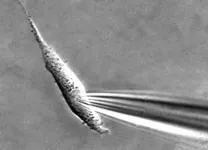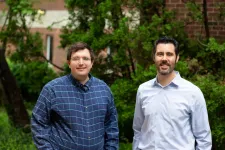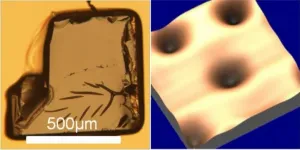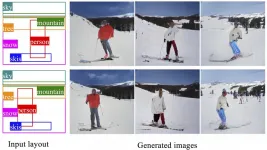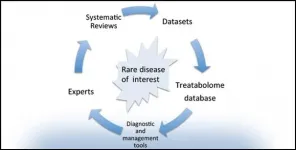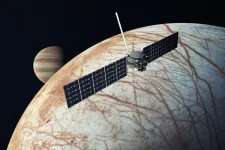(Press-News.org) Researchers working under the leadership of the Technical University of Munich (TUM) have conducted the first precise and comprehensive measurements of sea level rises in the Baltic Sea and the North Sea. A new method now makes it possible to determine sea level changes with millimeter accuracy even in coastal areas and in case of sea ice coverage. This is of vital importance for planning protective measures.
For the billions of people who live in coastal areas, rising sea levels driven by climate change can pose an existential threat. "To protect people and infrastructure - for example by building flood protection structures, securing ports or making dikes higher - we need reliable forecasts on sea level trends," explains Prof. Florian Seitz, the Director of the German Geodetic Research Institute at TUM. "However, this requires precise data with high spatial resolution. And until now, the required wide-area coverage was not available."
Especially near coastlines - where so many cities, ports, industry facilities and residential areas are located - the quality of data collected by the radar satellites orbiting the Earth for decades was compromised by high signal-to-noise ratios. The reason: Mountains, bays and offshore islands scatter the signals and distort the reflected echoes. Another problem is sea ice, which covers parts of the oceans in winter, and is impenetrable to radar.
In the Baltic Sea Level project (Baltic SEAL), a team of researchers at TUM worked with international partners to develop algorithms to process the measurement data from radar satellites to permit precise and high-resolution measurements of sea level changes even in coastal areas and beneath sea ice.
Penetrating ice and islands with radar
The researchers chose the Baltic Sea as the model region: "Data from this region are especially suitable for developing new methods because multiple factors make analysis difficult: The complex shape of the coastline, sea ice and wind. At the same time, there are plenty of local sea level measurements to corroborate the results," says project leader Dr. Marcello Passaro. "An analytical method that works in the Baltic Sea can be easily adapted to other regions."
To handle hundreds of millions of radar measurements taken between 1995 and 2019, the team developed a multi-stage process: In the first step, they calibrated the measurements from the various satellite missions so that they could be combined. With specially developed algorithms, they were then able to detect signals from the ice-covered sea water in the radar reflections produced along cracks and fissures. This made it possible to determine sea levels for the winter months. With new computational methods they also achieved better resolution of radar echoes close to land.
As a result, it is now possible to measure sea levels in coastal areas and compare the results with local tidal records. The processed data were then fitted to a fine grid with a resolution of 6 to 7 km using an algorithm developed by the team. The result: A highly precise data set covering the entire region.
The largest rises in sea levels are occurring in the Bay of Bothnia
The analysis of these data for the Baltic Sea shows the regional effects of the rise in sea levels over the past quarter century: The sea level has risen at an annual rate of 2 to 3 millimeters in the south, on the German and Danish coasts, as compared to 6 millimeters in the north-east, in the Bay of Bothnia. The cause of this large rise: Strong south-westerly winds that drive the waters to the north and eastward. This above-average increase in sea level does not pose a threat to coastal dwellers, however, because the land has been rising since the end of the last Ice Age - currently at an annual rate of up to 1 cm.
"Through the newly developed processes for analyzing and combining radar data, we are now in a position to arrive at precise and reliable conclusions on sea level changes in recent decades for other coastal regions as well," adds Dr. Denise Dettmering. The researcher has also created a comprehensive data set for the North Sea region: The sea level there is rising by 2.6 millimeters per year, and by 3.2 millimeters in the German Bight. Local trends can be determined using the data set and the user manual - both of which are freely accessible online. "With the data, researchers can verify their climate models, for example, and public authorities can plan suitable protective measures," says Dr. Seitz.
INFORMATION:
Publications:
* Passaro M, Müller FL, Oelsmann J, Rautiainen L, Dettmering D, Hart-Davis MG, Abulaitijiang A, Andersen OB, Høyer JL, Madsen KS, Ringgaard IM, Särkkä J, Scarrott R, Schwatke C, Seitz F, Tuomi L, Restano M and Benveniste J: Absolute Baltic Sea Level Trends in the Satellite Altimetry Era: A Revisit. Frontiers in Marine Science 8:647607, 2021. https://doi.org/10.3389/fmars.2021.647607
* Dettmering, D., Müller, F. L., Oelsmann, J., Passaro, M., Schwatke, C., Restano, M., Benveniste, J., Seitz, F.: NorthSEAL: A new Dataset of Sea Level Changes in the North Sea from Satellite Altimetry, Earth System Science Data [preprint], 2021. https://essd.copernicus.org/preprints/essd-2021-103/
More information:
* The European Space Agency (ESA) provides funding for the development of monitoring programs for various parameters of the Earth system, in particular to measure and analyze essential climate variables (ECVs). The ECVs are key criteria describing changes in the Earth's climate. One of them is the sea level. In 2018 the ESA launched a regional study on the Baltic Sea region (Baltic+ Initiative), including aspects of the marine ecosystem. DGFI-TUM is leading the Baltic SEAL project. Other participants are the Technical University of Denmark's National Space Institute, the Finnish Meteorological Institute, the Danish Meteorological Institute and University College Cork in Ireland.
Contact:
Dr. Marcello Passaro
Technical University of Munich
German Geodetic Research Institute (DGFI-TUM)
Tel.: +49 (89) 23031-1214
marcello.passaro@tum.de
Dr. Denise Dettmering
Technical University of Munich
German Geodetic Research Institute (DGFI-TUM)
Tel.: +49 (89) 23031-1198
denise.dettmering@tum.de
Cells have to constantly adapt to their surroundings in order to survive. A sudden increase in the environmental levels of an osmolyte, such as salt, causes cells to lose water and shrink. In a matter of seconds, they activate a mechanism that allows them to recover their initial water volume and avoid dying.
Finding out which genes are involved in surviving osmotic stress was the subject of a study led by the laboratories of Dr. Posas and Dr. de Nadal at the Institute for Research in Biomedicine (IRB Barcelona) and Dr. Valverde at Pompeu Fabra University (UPF), in collaboration with a group led by Dr. Moffat from the University of Toronto (Canada). wide-genome genetic screening, the scientists discovered the central role of a gene known as LRRC8A in cellular ...
In a joint effort, ct.qmat scientists from Dresden, Rostock, and Würzburg have accomplished non-Hermitian topological states of matter in topolectric circuits. The latter acronym refers to topological and electrical, giving a name to the realization of synthetic topological matter in electric circuit networks. The main motif of topological matter is its role in hosting particularly stable and robust features immune to local perturbations, which might be a pivotal ingredient for future quantum technologies. The current ct.qmat results promise a knowledge transfer from electric circuits to alternative optical platforms, and have just been published in Physical Review Letters.
Topological defect tuning in non-Hermitian systems
At the center of the currently reported work is the ...
Hydrogen peroxide (H2O2) is used to disinfect minor cuts at home and for oxidative reactions in industrial manufacturing. Now, the pandemic has further fueled demand for this chemical and its antiseptic properties. While affordable at the grocery store, H2O2 is actually difficult and expensive to manufacture at scale.
A team led by the University of Illinois Urbana-Champaign has demonstrated a more efficient and environmentally friendly method to produce H2O2, according to a recent study published in the Journal of the American Chemical Society.
"While the two ingredients--hydrogen and oxygen--are either inexpensive or freely available from the atmosphere, hydrogen peroxide is highly reactive and unstable, which makes it very hard to produce," said first author Tomas ...
TAMPA, Fla. - Moffitt Cancer Center, a national leader in cancer care and research and the only National Cancer Institute-designated Comprehensive Cancer Center based in Florida, is presenting new data from dozens of clinical research studies at this year's American Society of Clinical Oncology (ASCO) Annual Meeting, the world's largest clinical cancer research meeting. Moffitt investigators will lead 25 abstract presentations, five education sessions, two cancer-based panels and two clinical science symposia. The virtual meeting is June 4-8.
Highlights include:
Oral Presentations:
Dr. Bijal Shah will ...
Physicists at the University of Bath in the UK, in collaboration with researchers from the USA, have uncovered a new mechanism for enabling magnetism and superconductivity to co-exist in the same material. Until now, scientists could only guess how this unusual coexistence might be possible. The discovery could lead to applications in green energy technologies and in the development of superconducting devices, such as next-generation computer hardware.
As a rule, superconductivity (the ability of a material to pass an electrical current with perfect efficiency) and magnetism (seen at work in fridge magnets) make poor bedfellows because the alignment of the tiny electronic magnetic particles in ferromagnets ...
A catastrophic drop in atmospheric ozone levels around the tropics is likely to have contributed to a bottleneck in the human population around 60 to 100,000 years ago, an international research team has suggested. The ozone loss, triggered by the eruption of the Toba supervolcano located in present-day Indonesia, might solve an evolutionary puzzle that scientists have been debating for decades.
"Toba has long been posited as a cause of the bottleneck, but initial investigations into the climate variables of temperature and precipitation provided no concrete ...
In interstellar dust clouds, turbulence must first dissipate before a star can form through gravity. A German-French research team has now discovered that the kinetic energy of the turbulence comes to rest in a space that is very small on cosmic scales, ranging from one to several light-years in extent. The group also arrived at new results in the mathematical method: Previously, the turbulent structure of the interstellar medium was described as self-similar - or fractal. The researchers found that it is not enough to describe the structure mathematically as a single fractal, a self-similar structure as known from the Mandelbrot set. Instead, they added several different fractals, so-called multifractals. The new methods can thus be used to resolve ...
Researchers from North Carolina State University have developed a new state-of-the-art method for controlling how artificial intelligence (AI) systems create images. The work has applications for fields from autonomous robotics to AI training.
At issue is a type of AI task called conditional image generation, in which AI systems create images that meet a specific set of conditions. For example, a system could be trained to create original images of cats or dogs, depending on which animal the user requested. More recent techniques have built on this to incorporate conditions regarding an image layout. This allows users to specify which types of objects they want to appear in particular places on the screen. ...
Amsterdam, June 1, 2021 - The Treatabolome project is a research initiative to develop a freely available, interoperable online platform dedicated to disseminating rare disease and gene-specific treatment information to healthcare professionals regardless of their level of specialized expertise. Developed under the Solve-RD European Research Project, it is intended to reduce treatment delays for patients with rare diseases by directly linking diagnosis and treatment information. This initiative is highly relevant to neuromuscular disorders as they are rare diseases by definition. In this special issue of the Journal of Neuromuscular Diseases, experts contribute Treatabolome-feeding systematic literature reviews on rare neurological ...
Neutrons - Space ice, un-Earthly cold
Researchers from NASA's Jet Propulsion Laboratory and Oak Ridge National Laboratory successfully created amorphous ice, similar to ice in interstellar space and on icy worlds in our solar system. They documented that its disordered atomic behavior is unlike any ice on Earth.
The findings could help interpret data from future NASA missions such as Europa Clipper, which will assess the habitability of Jupiter's moon, Europa.
Using the Spallation Neutron Source's SNAP instrument, the scientists replicated the cold vacuum of space and added a few molecules ...
